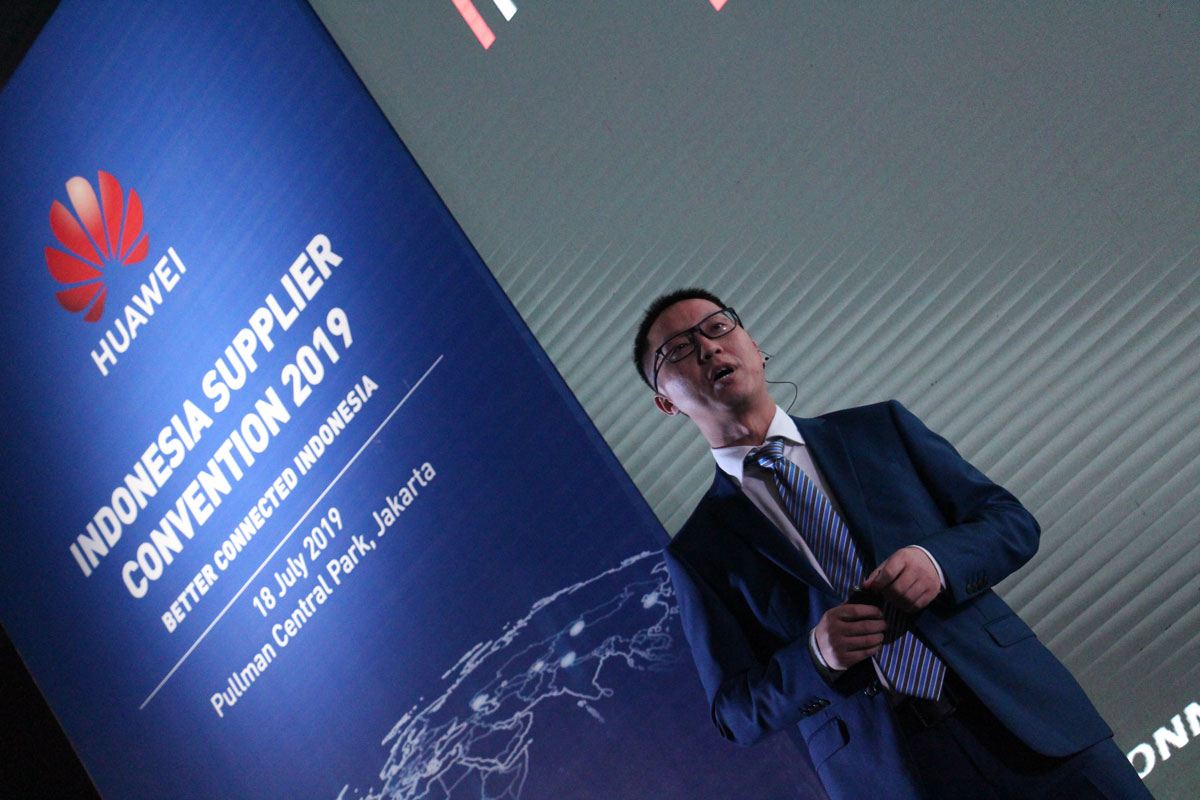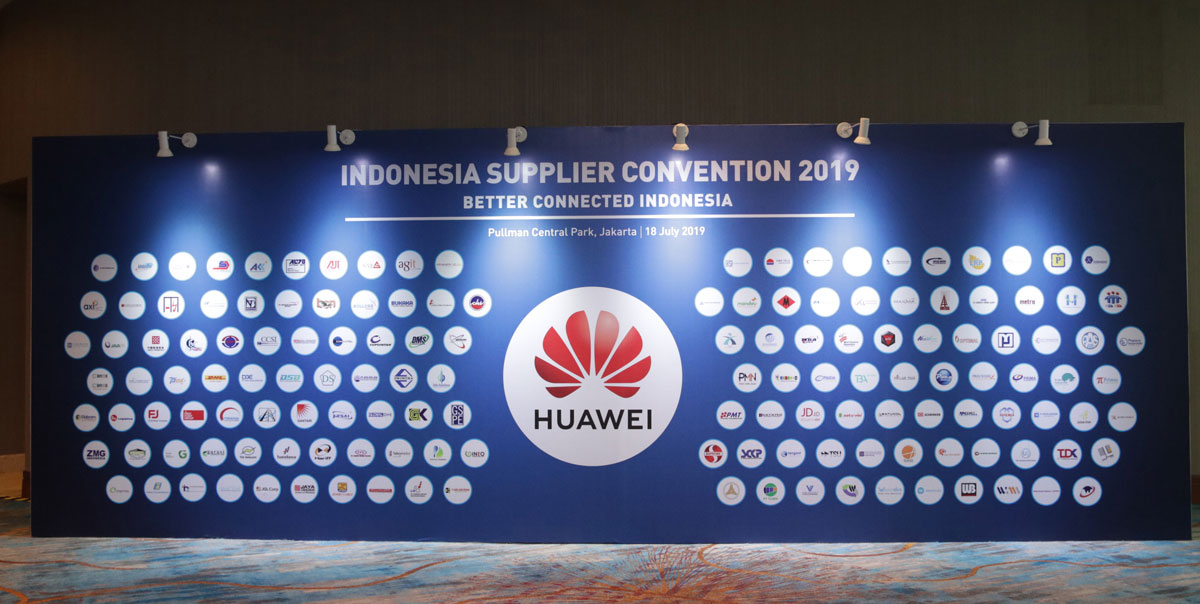The Chinese telecom giant Huawei opened an office in Indonesia in 2000. At that time, Huawei Indonesia kicked off its business by not only selling telecom devices but also as a consultant offering telecom solution packages to local providers and company, with a few employees and several partner companies who act as its subcontractors.
The Jakarta Post/Jakarta
Meanwhile, Huawei Indonesia has also grown in size, currently employing 2,000 people in its Jakarta office and partnering with around 200 partners which employs more than 40,000 employees across the archipelago. When they started working with Huawei, these partner subcontractors were also small-scale, employing around 15 to 20 employees. Almost 20 years later, these partners have also grown along with Huawei, currently employing around 200 to 300 employees.
The reason behind this growth? As a digital company, Huawei truly believes in the importance of nurturing proper digital ecosystem in countries where it operates in order to attain mutual growth for all sides of its business equation: the company itself, its partners and its clients.
One way in which Huawei maintains a proper business ecosystem is by helping its partners grow by steadfastly supplying them with the solutions they need to boost their business efficiency and effectiveness. This translates into more clients and more projects, which translate into business growth.

During an interview with The Jakarta Post, Huawei Vice President Yang Dong Hai illustrates how the company’s digital business process integration solution can help its partners boost their businesses.
“Let us say our client is building a base transceiver system (BTS). Before they use our digital integration solution, the client will typically take a few weeks to finish them because it has to involve a lot of manpower to do clerical tasks related to the BTS construction,” Yang says.
“After they use our solution, the time frame shortens to only two or three days, for instance, because our machine has already taken over the administrative works. Our real-time delivery monitoring system also helps our drivers to find shortcut roads to reach the site faster,” he adds.
Faster construction process translates into faster revenue generation and more spare time for companies to invest in other more productive activities, contributing to the national economic growth overall.
“We consider helping our partners customize their systems digitally by giving our services free of charge as part of our investment in them. They can use our platforms to record their every business activities. By making their businesses more efficient, we also lead the way to Indonesia’s industrial digitalization,” he says.
As a digital infrastructure vendor, Huawei – with the help of its partners – now caters to around 500 clients from various sectors, including government, infrastructure companies and many more. The company is looking forward to work more closely with the health and beauty sector to digitize their systems as well.
Any company which has formed a partnership with Huawei can tell that the cooperation always help them improve their business operations. These partners have some success stories to share.
Take a look at courier company DHL Supply Chain Indonesia as an instance. Once upon a time, the company frequently received complaints from its customers regarding its delivery service, usually on packages not being delivered on time or inaccuracies in delivery.
Its employees also used to work long hours, carrying out complicated tasks involving countless paperwork in order to track whereabouts of packages.
Employees in the company’s headquarters often found it hard to monitor couriers on-site because both sides were equally unfamiliar with the geographical setting that the couriers had to make their way through in order to reach their customers’ sites.
All the stress associated with these difficulties can also sometimes cause reduction in their work efficiency and accuracy.
Things begin to change, says DHL Supply Chain Indonesia Senior Director Operations Mario Lorenz, when the company starts adopting Huawei’s smart workplace solutions application, which helps the company digitalize all its operations with the use of real-time big data management.
DHL Supply Chain’s adoption of Huawei’s solution has helped the company turn itself into a paperless working system, saving itself from all the hassles and headaches involving piles of physical documents.
The warehouse application, which has integrated all logistical functions under one digitized system covering supply procurement, transportation process and on-site execution, has boosted the company’s accuracy in terms of procurement, labeling and delivery to 99.99 percent, reducing customer complaints and work hours dramatically.
The real-time delivery monitoring system provided by Huawei has especially been helpful to DHL Supply Chain: now, satellite imaging helps employees in the headquarters monitor delivery process immediately, while helping the delivery people arrive on site with punctuality by using the application to devise faster routes with them.
Thanks to the real-time delivery process monitoring system, the supplies can now be delivered on time, involving less amounts of tedious administrative works. Thereby, DHL Supply Chain’s clients can kick start their projects faster, which means they can say yes to new projects faster, translating into bigger revenues and business growth, boosting their trust in the company’s service quality.
DHL Supply Chain’s business improvement tells you only one story of the advancements that suppliers can make by working together with Huawei, which serves as a vendor for telecommunications companies across Indonesia to implement their network development projects, from material procurement on down to infrastructure construction.
Huawei supports its suppliers by providing them digital business solutions in the form of these applications so that they can carry out their businesses in a much more integrated and efficient way, ultimately helping these suppliers grow their businesses.
Huawei also trains its suppliers’ employees to operate these digital platforms for free.
The telecommunications company has chosen to give away their digital platform to their partners for free with the understanding that the digital economy works as an ecosystem: a telecom business will automatically grow when it also supports the growth of its partners.
Huawei’s other partners which have enjoyed similar solutions from the company has also shown significant business growth after partnering with the telecom giant.
PT Bukaka Teknik Utama Tbk (Bukaka), a company focusing on engineering design, construction and manufacturing in the energy, transportation and telecommunications sector, for instance, has recorded a total collaboration value worth Rp 399 billion (US$28.52 million) with Huawei.
Bukaka’s net income has grown over the years, also spurred by the digital system provided by Huawei.
Engineering company PT Nexwave Indonesia, meanwhile, reveals its collaboration with Huawei to be a ‘win-win partnership’ as Huawei’s support has helped the company expand its business 16 times bigger than 10 years ago, before they started working together.
Among Huawei’s partners, business growth also translates into larger capacities for job creation. Indonesian mobile telecommunications company PT Putra Mulia Telecommunications (PMT), meanwhile, says that its value-added partnership with Huawei has helped it grow from only 10 employees in 2011 to currently about 1,000 employees covering the entire nation.
As a telecommunications firm which was established in 1987, Huawei is always happy to share its expertise with its partners. “PMT has learned a lot of telecommunications business function matters from Huawei,” PMT Chief Executive Officer Lim Hooi Seeh says.
Huawei has attributed its business growth to its willingness to collaborate closely with its partners to create a mutually beneficial digital ecosystem through their partnerships. Along with the growth of its local and global partners, Huawei’s global business has also been growing so far.
In June 2019, Huawei reported first quarter revenue growth of 39 percent year-on-year (yoy) to US$26.8 billion. In the same period, Huawei's smartphone shipments soared 50 percent yoy, while at the same time Apple's shipments dropped 30 percent and Samsung's by 8 percent.
With the new figures, Huawei captured a 19 percent share of the global smartphone market in the first quarter of 2019. Huawei commanded a 31 percent share in global mobile infrastructure equipment in 2018.
The company itself is well aware that in order for its business to truly flourish, taking care only of its partners’ ecosystem alone is not enough: it also has to make sure that on a national level, Indonesia has a sound digital economy infrastructure.
This is why the company is hoping that the 5G connection technology it is currently developing will benefit Indonesia’s emerging market from the rapid connection it enables. So far, Huawei has won 50 commercial contracts and shipped more than 150,000 BTS equipment across the world. As illustration, the total BTS across Indonesia is around 120,000.
With Earth’s depleting natural resources, people are already aware that data mining, powered by the digital economy, will be the new frontier of the global economy. This also rings true for Indonesia as well. Better connectivity in Indonesia also means higher growth for Huawei and its partners.
“Therefore, we are looking forward to welcoming a better connected Indonesia,” Yang says.
Indonesia’s road to total industrial digitalization is still rocky, though. The country still has to address many challenges to get there.
Bukaka President Director Irsal Kamarudin acknowledges that with more than 17,000 islands scattered all over the Indonesian archipelago, comprising various remote areas lacking proper infrastructure, making telecommunication services available across all corners of the country is no easy feat.
Huawei and Bukaka’s concern in making telecommunication infrastructure available to all Indonesians in any parts of the country goes beyond business as usual, apparently. Irsal argues that improved connectivity can also help the country boost its good governance practices, social welfare protection and disaster risk management.
“For instance, digital platforms can help local governments increase transparency by offering citizens easy access to administrative application forms and services,” Irsal says.
Another difficult issue has also surfaced: with digitized systems replacing human beings, how will Indonesians – most of whom still stuck in the low-skill labor zone – find jobs in the future?
To address this challengeTo address this challenge, while remaining faithful to its motto of creating win-win ecosystem in countries where it operates, this year Huawei is working together with the Manpower Ministry to provide 1,000 vocational school students coursework on how to install BTS and microwave stations by using the company’s digital platform.







